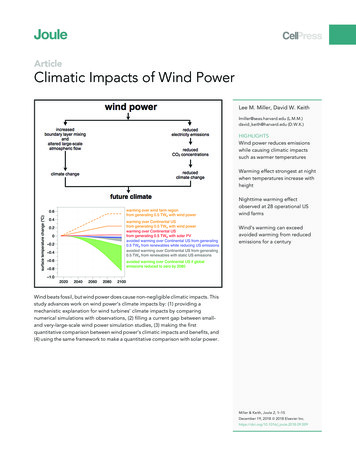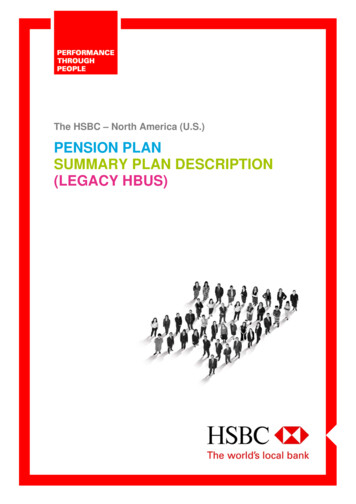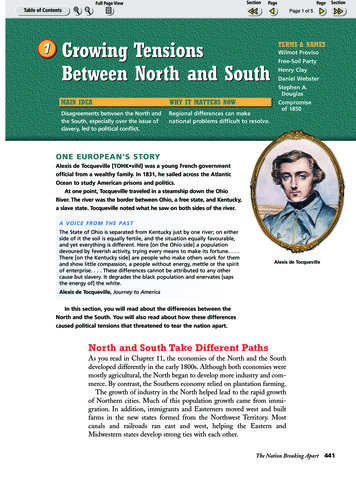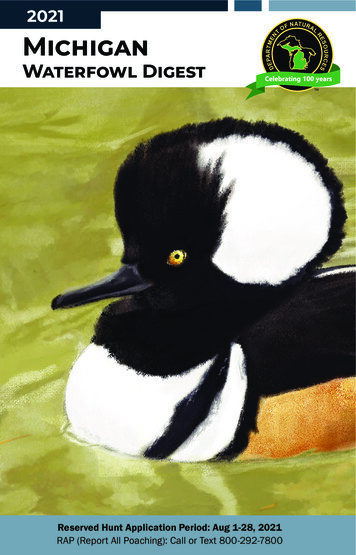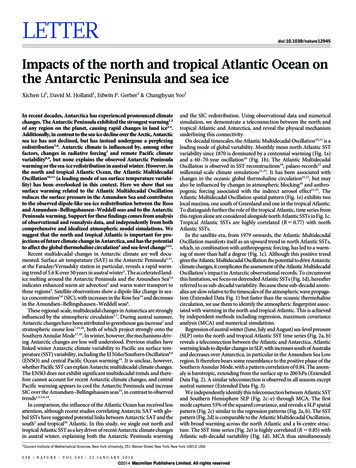
Transcription
LETTERdoi:10.1038/nature12945Impacts of the north and tropical Atlantic Ocean onthe Antarctic Peninsula and sea iceXichen Li1, David M. Holland1, Edwin P. Gerber1 & Changhyun Yoo1In recent decades, Antarctica has experienced pronounced climatechanges. The Antarctic Peninsula exhibited the strongest warming1,2of any region on the planet, causing rapid changes in land ice3,4.Additionally, in contrast to the sea-ice decline over the Arctic, Antarcticsea ice has not declined, but has instead undergone a perplexingredistribution5,6. Antarctic climate is influenced by, among otherfactors, changes in radiative forcing7 and remote Pacific climatevariability8,9, but none explains the observed Antarctic Peninsulawarming or the sea-ice redistribution in austral winter. However, inthe north and tropical Atlantic Ocean, the Atlantic MultidecadalOscillation10,11 (a leading mode of sea surface temperature variability) has been overlooked in this context. Here we show that seasurface warming related to the Atlantic Multidecadal Oscillationreduces the surface pressure in the Amundsen Sea and contributesto the observed dipole-like sea-ice redistribution between the Rossand Amundsen–Bellingshausen–Weddell seas and to the AntarcticPeninsula warming. Support for these findings comes from analysisof observational and reanalysis data, and independently from bothcomprehensive and idealized atmospheric model simulations. Wesuggest that the north and tropical Atlantic is important for projections of future climate change in Antarctica, and has the potentialto affect the global thermohaline circulation6 and sea-level change3,12.Recent multidecadal changes in Antarctic climate are well documented. Surface air temperature (SAT) in the Antarctic Peninsula2,13,at the Faraday/Vernadsky station in particular, reveals a rapid warming trend of 5.6 K over 50 years in austral winter1. The accelerated landice melting around the Antarctic Peninsula and the Amundsen Sea3,4indicates enhanced warm air advection3 and warm water transport tothese regions4. Satellite observations show a dipole-like change in seaice concentration5,6 (SIC), with increases in the Ross Sea14 and decreasesin the Amundsen–Bellingshausen–Weddell seas6.These regional-scale, multidecadal changes in Antarctica are stronglyinfluenced by the atmospheric circulation1,7. During austral summer,Antarctic changes have been attributed to greenhouse gas increase7 andstratospheric ozone loss7,15,16, both of which project strongly onto theSouthern Annular Mode17,18. In winter, however, the mechanisms driving Antarctic changes are less well understood. Previous studies havelinked winter Antarctic climate variability to Pacific sea surface temperature (SST) variability, including the El Niño/Southern Oscillation8,9(ENSO) and central Pacific Ocean warming19. It is unclear, however,whether Pacific SST can explain Antarctic multidecadal climate changes.The ENSO does not exhibit significant multidecadal trends and therefore cannot account for recent Antarctic climate changes, and centralPacific warming appears to cool the Antarctic Peninsula and increaseSIC over the Amundsen–Bellingshausen seas19, in contrast to observedtrends1,2,5,6,14.In comparison, the influence of the Atlantic Ocean has received lessattention, although recent studies correlating Antarctic SAT with global SSTs have suggested potential links between Antarctic SAT and thesouth2 and tropical20 Atlantic. In this study, we single out north andtropical Atlantic SST as a key driver of recent Antarctic climate changesin austral winter, explaining both the Antarctic Peninsula warming1and the SIC redistribution. Using observational data and numericalsimulation, we demonstrate a teleconnection between the north andtropical Atlantic and Antarctica, and reveal the physical mechanismunderlining this connectivity.On decadal timescales, the Atlantic Multidecadal Oscillation10,21 is aleading mode of global variability. Monthly mean north Atlantic SSTvariability since 1870 is dominated by a centennial warming (Fig. 1a)and a 60–70-year oscillation10 (Fig. 1b). The Atlantic MultidecadalOscillation is observed in SST reconstructions10, palaeo-records22 andmillennial-scale climate simulations21,23. It has been associated withchanges in the oceanic global thermohaline circulation21,23, but mayalso be influenced by changes in atmospheric blocking24 and anthropogenic forcing associated with the indirect aerosol effect11,25. TheAtlantic Multidecadal Oscillation spatial pattern (Fig. 1e) exhibits twolocal maxima, one south of Greenland and one in the tropical Atlantic.To distinguish further the role of the tropical Atlantic, time series fromthis region alone are considered alongside north Atlantic SSTs in Fig. 1c.Tropical Atlantic SSTs are highly correlated (R 5 0.77) with northAtlantic SSTs.In the satellite era, from 1979 onwards, the Atlantic MultidecadalOscillation manifests itself as an upward trend in north Atlantic SSTs,which, in combination with anthropogenic forcing, has led to a warming of more than half a degree (Fig. 1c). Although this positive trendgives the Atlantic Multidecadal Oscillation the potential to drive Antarcticclimate changes, it complicates the assessment of the Atlantic MultidecadalOscillation’s impact in Antarctic observational records. To circumventthis limitation, we focus on detrended Atlantic SSTs (Fig. 1d), hereafterreferred to as sub-decadal variability. Because these sub-decadal anomalies are slow relative to the timescales of the atmospheric wave propagation (Extended Data Fig. 1) but faster than the oceanic thermohalinecirculation, we use them to identify the atmospheric fingerprint associated with warming in the north and tropical Atlantic. This is achievedby independent methods including regression, maximum covarianceanalysis (MCA) and numerical simulations.Regression of austral winter (June, July and August) sea-level pressure(SLP) onto the north and tropical Atlantic SST time series (Fig. 2a, b)reveals a teleconnection between the Atlantic and Antarctica. Atlanticwarming leads to dipolar changes in SLP, with increases south of Australiaand decreases over Antarctica, in particular in the Amundsen Sea Lowregion. It therefore bears some resemblance to the positive phase of theSouthern Annular Mode, with a pattern correlation of 0.84. The anomaly is barotropic, extending from the surface up to 200 hPa (ExtendedData Fig. 2). A similar teleconnection is observed in all seasons exceptaustral summer (Extended Data Fig. 3).We independently identify this teleconnection between Atlantic SSTand Southern Hemisphere SLP (Fig. 2c–e) through MCA. The firstmode captures 55% of the squared covariance, and reveals a SLP spatialpattern (Fig. 2c) similar to the regression patterns (Fig. 2a, b). The SSTpattern (Fig. 2d) is comparable to the Atlantic Multidecadal Oscillation,with broad warming across the north Atlantic and a bi-centre structure. The SST time series (Fig. 2e) is highly correlated (R 5 0.85) withAtlantic sub-decadal variability (Fig. 1d). MCA thus simultaneouslyCourant Institute of Mathematical Sciences, New York University, 251 Mercer Street, New York, New York 10012, USA.5 3 8 N AT U R E VO L 5 0 5 2 3 J A N U A RY 2 0 1 4 2014 Macmillan Publishers Limited. All rights reserved
LETTER RESEARCHae Spatial patternRaw North Atlantic mean SSTLinear trendCentennial0.8SST (K)0.6SST (K)0.40.30.20–0.2–0.4Start of high-qualitysatellite data in 1979–0.6b0.6Multi-decadal60º N0.15Unsmoothed AMO time seriesAMO time seriesSST (K)0.400.230º N0–0.2 0.15–0.4cdSST .6Detrend0º 0.390º W60º W30º W0º30º EFigure 1 Temporal variability of north and tropical Atlantic sea surfacetemperature anomalies at different timescales, and the spatial pattern of theAtlantic Multidecadal Oscillation. a, Area-weighted monthly mean SST inthe north Atlantic (0u N–70u N) since 1870. The grey dashed line indicates thecentennial trend. b, The blue curve shows mean SST after removing the lineartrend signal and the green curve indicates the Atlantic Multidecadal Oscillationindex, defined as a ten-year smoothed mean of the detrended time series.c, 1979–2012 (black box in a) austral winter monthly mean SST time series. Theblue (or red) curve shows mean SST over the north (or tropical) Atlantic. Thenorth (or tropical) Atlantic region is defined by the blue (or red) rectangle ine; the Pacific sector inside each box is excluded. The linear trends are indicatedby the dashed lines in c, which are a superposition of the global warming trendin a and the ascending Atlantic Multidecadal Oscillation index in b. d, Thedetrended time series of c serve as indices of the north and tropical Atlantic subdecadal variability and are used in regression. e, The spatial pattern of theAtlantic Multidecadal Oscillation, defined as the normalized regression ofnorth Atlantic SST (1870–2012) against the Atlantic Multidecadal Oscillationindex, exhibiting two warm centres, one south of Greenland and one in thetropics.reproduces the Atlantic Multidecadal Oscillation pattern and associates it with the Antarctic SLP teleconnection.We establish a causal link between Atlantic SSTs and the AntarcticSLP pattern with numerical simulations using the Community Atmosphere Model (CAM4), a state-of-the-art atmospheric model (see Methodsfor details). The simulated SLP response to north (Fig. 2f) and tropical(Fig. 2g) Atlantic warming is comparable to the SLP pattern obtainedfrom regression and MCA. The model reproduces the amplification ofthe Amundsen Sea Low, albeit with an eastward shift.The simulation results suggest that warming in the tropical Atlanticgenerates the bulk of the SLP response to the whole Atlantic MultidecadalOscillation pattern (Fig. 2f, g). The SLP response to warming in themid-latitude north Atlantic is comparatively weaker (Extended DataFig. 4). The SLP response to the Atlantic Multidecadal Oscillation canbe viewed as a linear combination of the responses to mid-latitudenorth and tropical Atlantic warming, with the latter playing the keypart.Geostrophic balance connects SLP changes to surface wind anomalies, which affect regional-scale changes in SIC and SAT6,14,26. Regressionof SLP, SIC and SAT onto tropical Atlantic sub-decadal variability(Fig. 3a) reveals the impact of the atmospheric teleconnection onAntarctic SIC and SAT. In particular, the low-pressure anomaly inthe Amundsen Sea induces a cyclonic (clockwise) circulation, heatingthe Antarctic Peninsula by warm-air advection14 (red arrows in Fig. 3a).Changes in thermal advection and wind-stress forcing associated withsurface wind anomalies drive a SIC dipole redistribution6,26. Local feedbacks between the sea ice and the ocean may considerably amplify theinitial response triggered by the wind forcing27,28.To assess the statistical significance of the SIC and SAT patternsassociated with Atlantic SSTs, we must also take into account the spatialstructure of the response. The aggregated SIC increase across the RossSea, the SIC loss in the Amundsen–Bellingshausen–Weddell seas, andthe SAT warming of the Antarctic Peninsula are statistically significant(see Methods and Extended Data Fig. 8).Thus far we have established a climatic fingerprint of Atlantic warming on Antarctic climate (Fig. 3a) from sub-decadal variability. Becausethe timescales of the atmospheric circulation are fast relative to subdecadal oceanic variability, the multidecadal response of Antarcticclimate to Atlantic warming may also exhibit the same fingerprint.Multidecadal changes of SIC and SAT are shown in Fig. 3b. ReanalysisSAT is potentially biased over Antarctica29, so we also include groundstation SAT trends. SIC exhibits expansion around Antarctica, accompanied with a dipole redistribution between the Ross Sea and theAmundsen–Bellingshausen–Weddell seas6,14 that is consistent with adeepening of the Amundsen Sea Low14,18. Both station observationsand reanalysis SAT indicate a strong warming signal over the AntarcticPeninsula1, although the cooling signal over Marie Byrd Land in theregression differs from observations30, indicating that Atlantic SSTchanges do not explain the entire spatial pattern of west Antarctic warming. In east Antarctica, regression results (Fig. 3a) agree with stationobservations (Fig. 3b), both revealing a mild cooling trend. The reanalysis (Fig. 3b) indicates a warming tendency, but may be biased bysurface energy balance errors29.A comparison of Fig. 3a and Fig. 3b reveals a strong resemblancebetween the sub-decadal fingerprint and the multidecadal changes inSIC and SAT. The SIC and SAT anomalies in Fig. 3a are associatedwith one standard deviation of the Atlantic SST variability, which isapproximately 0.2 K. The net warming trend in the tropical Atlanticduring the period 1979–2012, however, is approximately 0.5 K. Assuminga linear relationship between Atlantic SST and SIC/SAT, the amplitudeof the fingerprint in Fig. 3a should be scaled by a factor of two, thusmaking it comparable to the multidecadal changes (Fig. 3b).2 3 J A N U A RY 2 0 1 4 VO L 5 0 5 N AT U R E 5 3 9 2014 Macmillan Publishers Limited. All rights reserved
RESEARCH LETTERabSLP (Pa)0º0º20030º S19851995100200530º S1985 19952005060º S60º S 100 2000º60º E120º E180º W120º W60º W0º0ºcSLP (Pa)4000º60º E120º Ed180º W120º W60º WSSTSLP0.560º N20030º S0ºe0030º N60º S 200–0.50º 4000º60º E120º E180º W120º W60º W0º60º W0º19801990180º W120º W20002010gfSLP (Pa)0º0º3002001000 100 200 30030º S60º S0º60º E120º E180º W120º W60º W60º S0º0ºFigure 2 North and tropical Atlantic variability projected onto australwinter Southern Hemisphere SLP by three independent analyses. a, b, Thenormalized regression of SLP against north Atlantic SST (a; the inset showsthe time series) and tropical Atlantic SST (b). Areas of .95% significance(Student’s t-test) are marked by black dots, restricted to the shaded regions.c–e, The first mode of MCA, including the spatial patterns of SLP (c) and SST(d), as well as their time series (e; unit free). f, g, Simulated SLP anomalya30º S60º nadskyRotheraBellingshausen SeaWeddell SeaHalleyAmundsen SeaNeumayerOffshoredriftingNovolazarevskayaHaakon VII SeaAmundsen-ScottRoss SeaSyowa80ºMawsonDumont d’UrvilleCold advectionMirnyCaseyStation SAT (K) 1 3 0.6 0.20.2S60ºDavisSIC (%)(%0.6 6 2210.3 0.5 0.7 0.9 1SAT (K)6 2 10(%SIC (%)12Figure 3 The austral winter patterns of Antarctic SLP, SAT and SIC relatedto tropical Atlantic SST warming. a, SLP (red and blue contours indicatepositive and negative anomalies respectively, 40 Pa interval), SAT (land-areacolour) and SIC (ocean-area colour), individually regressed against thenormalized tropical Atlantic SST. The regression on the north Atlantic SSTshows similar signals, not shown. Atlantic SST-induced SAT/SIC patternsare consistent with SLP, via the mechanisms of thermal advection (red/bluearrows) and mechanical stress forcing (grey arrows). b, Epochal differences(1996–2012 minus 1979–1995) of SIC and SAT. SAT observations from 18Davis SeaDumont d’UrvilleSeaStation significance3S70ºSS60ºS70ºVostokS80ºScott BaseSAT (K)0ºcOnshoredriftingOffshoredrifting60º Wresponse to north Atlantic SST warming (f; the inset shows SST forcing) andtropical Atlantic SST warming (g; the inset shows SST forcing). The threeanalyses (a, c and f ) show a coherent spatial pattern, suggesting a robust linkbetween north Atlantic warming and Antarctic SLP and circulation anomalies.Evidence from simulation (f, g) implies an impact and causality coming fromboth the north and tropical Atlantic.bWarm advection120º E 20 10010SAT (K)20 2 1.5 1 0.500.511.52stations are also superimposed (circles, with colour showing the trends, and sizecorresponding to significance level). The Atlantic Multidecadal Oscillationspatial pattern is shown in the upper left. The similarity between sub-decadalvariability (a) and multidecadal trends (b) implies a teleconnection between theAtlantic Multidecadal Oscillation and recent Antarctic climate change. Theepochal difference of SLP is not shown in b because there exist uncertainties inthe SLP reanalysis data. c, Simulated SLP (contours with 80 Pa interval) andSAT (colour) response to tropical Atlantic SST forcing (SIC is not included inthe simulation) reveals causality in the above teleconnection.5 4 0 N AT U R E VO L 5 0 5 2 3 J A N U A RY 2 0 1 4 2014 Macmillan Publishers Limited. All rights reserved
LETTER RESEARCHThe CAM4 simulations also suggest that the observed trend in SATis a consequence of the circulation changes driven by tropical Atlanticwarming. The SLP and SAT response to climatological tropical AtlanticSST forcing in CAM4 (Fig. 3c) nearly matches the regression results(Fig. 3a) and observed multidecadal trends (Fig. 3b). The amplitude ofthe CAM4 SAT patterns, however, should be interpreted with somecaution. SAT in the polar region is affected by SIC changes, so the totalresponse triggered by the atmospheric circulation change may depend onair–sea-ice–ocean interactions that are missing from our atmosphereonly model.Remarkably, the SLP, SAT and SIC patterns obtained from subdecadal regression, multidecadal observational trends and atmosphericmodel simulations all reveal a similar teleconnection between the northand tropical Atlantic and Antarctica. The regression and MCA resultswere derived using detrended, sub-decadal variability, and thus cannotindependently inform us about multidecadal trends. However, giventhat the timescales of atmospheric variability are fast compared to subdecadal climate variability, this sub-decadal teleconnection may implythe existence of a multidecadal link. The coherence between the multidecadal trend (Fig. 3b) and detrended sub-decadal regression (Fig. 3a)significantly strengthens this argument, and the model simulations(Fig. 3c) establish causality, showing that Atlantic Multidecadal Oscillation SST forcing is a key driver of recent Antarctic climate change.The mechanism by which tropical SSTs drive Antarctic atmosphericcirculation depends critically on poleward propagating Rossby wavetrains8. (Rossby waves are large-scale atmospheric wave structures thatarise from variations in the effect of planetary rotation with latitude.) Asimilar physical process has been examined in previous studies9,19, butfocusing only on the tropical Pacific. In contrast, we simulate Rossbywave trains driven by tropical Atlantic SSTs (Fig. 2f, g and ExtendedData Fig. 1g). CAM4 is a comprehensive atmospheric model thatincludes a wide array of physical processes, so it is difficult to isolatepure Rossby wave dynamics unambiguously. To focus on these dynamicsalone, we performed idealized simulations with the ‘dry dynamicalcore’ of a Geophysical Fluid Dynamics Laboratory (GFDL) atmospheric model (see Methods for details). Using austral winter background conditions (Extended Data Fig. 1a–f ), we demonstrate thatconvective heating over the tropical Atlantic generates Rossby wavetrains that propagate around the globe within two weeks, ultimatelyfocusing on and enhancing the Amundsen Sea Low. This wave patternmatches well with CAM4 simulations (Extended Data Fig. 1g), andfurther establishes that Rossby wave trains directly link the tropicalAtlantic to Antarctica.Although we have used subdecadal variability to identify the teleconnection from the north and tropical Atlantic to the Antarcticregion, it is important to note that Pacific SST variability—the ENSOin particular—dominates the interannual variability of Antarcticclimate8,9,27. The Atlantic, however, becomes a dominant driver of Antarctic climate on multidecadal timescales (see Methods and ExtendedData Fig. 6).In addition to the demonstrated impacts on SAT and SIC, this studyimplies broader impacts of north and tropical Atlantic warming, specifically on global sea-level change and the thermohaline circulation.The dramatic breakup of the Larsen A and B ice shelves and the presentthinning of the C shelf have been attributed to atmospheric thermaladvection3, shown in this study to be driven, in part, by north andtropical Atlantic warming. These surface land-ice changes, in conjunction with basal melting processes caused by sub-ice-shelf intrusion ofwarm water, are contributing to an accelerated global sea-level rise12.Additionally, the SAT and SIC in the Weddell Sea, which we haveshown to be sensitive to the Atlantic Multidecadal Oscillation, arecritical to the formation of Antarctic bottom water6, an importantgenerator of the thermohaline circulation. The Atlantic MultidecadalOscillation itself is considered to be the ocean surface response tochanges in the thermohaline circulation21,23. This raises the possibilitythat the Atlantic Multidecadal Oscillation directly interacts with thethermohaline circulation in the Southern Ocean. Such an interactionmay be important for understanding the climate system on multidecadal and even longer timescales.METHODS SUMMARYWe used linear regression, MCA decomposition and two numerical models in thisstudy. Statistical confidence levels are shown with linear regression indices, andMCA decomposition identifies the mode that maximizes the covariance betweentwo different variables. The CAM4 response to Atlantic Multidecadal OscillationSST forcing was obtained as the difference between a control run forced with 1980sboundary conditions and a perturbation run in which only SSTs in the north andtropical Atlantic were modified. The GFDL model shows the dynamical responseto an idealized initial perturbation, mimicking the Atlantic Multidecadal Oscillation SST warming.Online Content Any additional Methods, Extended Data display items and SourceData are available in the online version of the paper; references unique to thesesections appear only in the online paper.Received 19 August; accepted 10 December 19.20.21.22.23.24.25.Vaughan, D. G., Marshall, G. J., Connolley, W. M., King, J. C. & Mulvaney, R. Devil inthe detail. Science 293, 1777–1779 (2001).Schneider, D. P., Deser, C. & Okumura, Y. An assessment and interpretation of theobserved warming of West Antarctica in the austral spring. Clim. Dyn. 38, 323–347(2012).Pritchard, H. et al. Antarctic ice-sheet loss driven by basal melting of ice shelves.Nature 484, 502–505 (2012).Joughin, I., Alley, R. B. & Holland, D. M. Ice-sheet response of oceanic forcing.Science 338, 1172–1176 (2012).Yuan, X. & Martinson, D. G. The Antarctic dipole and its predictability. Geophys. Res.Lett. 28, 3609–3612 (2001).Holland, P. R. & Kwok, R. Wind-driven trends in Antarctic sea-ice drift. NatureGeosci. 5, 872–875 (2012).Arblaster, J. M. & Meehl, G. A. Contributions of external forcings to southernannular mode trends. J. Clim. 19, 2896–2905 (2006).Karoly, D. J. Southern hemisphere circulation features associated with El NiñoSouthern Oscillation events. J. Clim. 2, 1239–1252 (1989).Fogt, R. L., Bromwich, D. H. & Hines, K. M. Understanding the SAM influence on theSouth Pacific ENSO teleconnection. Clim. Dyn. 36, 1555–1576 (2011).Schlesinger, M. E. & Ramankutty, N. An oscillation in the global climate system ofperiod 65–70 years. Nature 367, 723–726 (1994).Booth, B. B., Dunstone, N. J., Halloran, P. R., Andrews, T. & Bellouin, N. Aerosolsimplicated as a prime driver of twentieth-century North Atlantic climate variability.Nature 484, 228–232 (2012).King, M. A. et al. Lower satellite-gravimetry estimates of Antarctic sea-levelcontribution. Nature 491, 586–589 (2012).O’Donnell, R., Lewis, N., McIntyre, S. & Condon, J. Improved methods for PCAbased reconstructions: case study using the Steig et al. (2009) Antarctictemperature reconstruction. J. Clim. 24, 2099–2115 (2011).Stammerjohn, S. E., Martinson, D. G., Smith, R. C., Yuan, X. & Rind, D. Trends inAntarctic annual sea ice retreat and advance and their relation to El Niño–SouthernOscillation and Southern Annular Mode variability. J. Geophys. Res. 113, C03S90(2008).Son, S. W. et al. The impact of stratospheric ozone recovery on the SouthernHemisphere westerly jet. Science 320, 1486–1489 (2008).Turner, J. et al. Non-annular atmospheric circulation change induced bystratospheric ozone depletion and its role in the recent increase of Antarctic sea iceextent. Geophys. Res. Lett. 36, L08502 (2009).Thompson, D. et al. Signatures of the Antarctic ozone hole in Southern Hemispheresurface climate change. Nature Geosci. 4, 741–749 (2011).Marshall, G. J. Trends in the Southern Annular Mode from observations andreanalyses. J. Clim. 16, 4134–4143 (2003).Ding, Q., Steig, E. J., Battisti, D. S. & Küttel, M. Winter warming in West Antarcticacaused by central tropical Pacific warming. Nature Geosci. 4, 398–403 (2011).Okumura, Y. M., Schneider, D., Deser, C. & Wilson, R. Decadal–interdecadal climatevariability over antarctica and linkages to the tropics: analysis of ice core,instrumental, and tropical proxy data. J. Clim. 25, 7421–7441 (2012).Knight, J. R., Allan, R. J., Folland, C. K., Vellinga, M. & Mann, M. E. A signature ofpersistent natural thermohaline circulation cycles in observed climate. Geophys.Res. Lett. 32, L20708 (2005).Gray, S. T., Graumlich, L. J., Betancourt, J. L. & Pederson, G. T. A tree-ring basedreconstruction of the Atlantic Multidecadal Oscillation since 1567 A.D. Geophys.Res. Lett. 31, L12205 (2004).Zhang, R. & Delworth, T. L. A new method for attributing climate variations over theAtlantic Hurricane Basin’s main development region. Geophys. Res. Lett. 36,L06701 (2009).Häkkinen, S., Rhines, P. B. & Worthen, D. L. Atmospheric blocking and Atlanticmultidecadal ocean variability. Science 334, 655–659 (2011).Ting, M., Kushnir, Y., Seager, R. & Li, C. Forced and internal twentieth-century SSTTrends in the North Atlantic. J. Clim. 22, 1469–1481 (2009).2 3 J A N U A RY 2 0 1 4 VO L 5 0 5 N AT U R E 5 4 1 2014 Macmillan Publishers Limited. All rights reserved
RESEARCH LETTER26. Lefebvre, W. & Goosse, H. Influence of the Southern Annular Mode on the sea iceocean system: the role of the thermal and mechanical forcing. Ocean Sci. Discuss.2, 299–329 (2005).27. Stammerjohn, S., Massom, R., Rind, D. & Martinson, D. Regions of rapid sea icechange: An inter-hemispheric seasonal comparison. Geophys. Res. Lett. 39,L06501 (2012).28. Goosse, H. & Zunz, V. Decadal trends in the Antarctic sea ice extent ultimatelycontrolled by ice-ocean feedback. Cryosphere Discuss. 7, 4585–4632 (2013).29. Bracegirdle, T. J. & Marshall, G. J. The reliability of Antarctic tropospheric pressureand temperature in the latest global reanalyses. J. Clim. 25, 7138–7146 (2012).30. Bromwich, D. H. et al. Central West Antarctica among the most rapidly warmingregions on Earth. Nature Geosci. 6, 139–145 (2013).Acknowledgements X.L., D.M.H. and C.Y. were supported by the NSF Office of PolarPrograms (grant number ANT-0732869), the NASA Polar Programs (grant numberNNX12AB69G), and New York University Abu Dhabi (grant number G1204). E.P.G. wassupported by the NSF Office of Atmospheric and Geospace Sciences (grant numberAGS-1264195). The HadISST SST and SIC data was provided by the British Met Office,Hadley Centre. The Antarctic weather station data was made available by the BritishAntarctic Survey. The MERRA atmospheric reanalysis data was provided by the GlobalModeling and Assimilation Office (GMAO) at NASA Goddard Space Flight Center(GSFC) through the NASA Goddard Earth Sciences (GES) Data and InformationServices Center (DISC) online archive /merra/merra products nonjs.shtml). The ERA-Interim atmosphericreanalysis was provided by the ECMWF. The comprehensive atmospheric model(CAM4) was made available by the National Center for Atmospheric Research (NCAR),supported by the National Science Foundation (NSF) and the Office of Science (BER) ofthe US Department of Energy (DOE). The idealized atmospheric model (the GFDL drydynamical core) was developed by the National Oceanic and AtmosphericAdministration (NOAA) at the GFDL. Computing resources were provided by theNational Energy Research Scientific Computing Center (NERSC) and HighPerformance Computing (HPC) at New York University (NYU).Author Contributions X.L., D.M.H. and E.P.G. designed the experiments; X.L. performedthe data analysis and CAM4 numerical simulations, and prepared all figures; C.Y. ranthe initial value calculations; C.Y. and X.L. created Extended Data Fig. 1 and all authorswrote and reviewed the main manuscript text.Author Information Reprints and permissions information is available atwww.nature.com/reprints. The authors declare no competing financial interests.Readers are welcome to comment on the online version of the paper. Correspondenceand requests for materials should be addressed to X.L. (xichen@cims.nyu.edu).5 4 2 N AT U R E VO L 5 0 5 2 3 J A N U A RY 2 0 1 4 2014 Macmillan Publishers Limited. All rights reserved
LETTER RESEARCHMETHODSData sets. The Modern Era Retrospective analysis for Research and Applications(MERRA) data sets were generated by NASA, using the GEOS-5 Data AssimilationSystem with a resolution of half a degree by two-thirds of a degree31. We used themonthly mean version of MERRA from January 1979 to September 2012, obtainedfrom the NASA Goddard Earth Sciences Data and Information Services ldings). MERRA reanalysis of SLP andSAT (over land only) is shown in Figs 2 and 3.The ECMWF Interim Re-Analysis (ERA-Interim) was produced by the EuropeanCentre for Medium Range Weather Forecasts (ECMWF) using four-dimensionalvariational assimilation32. The resolution of the atmospheric model (IFS Cy31r1/2)is T255 (nominally 0.7 degrees). We used the monthly mean version of ERA-Interimfrom January 1979 to December 2010, available from the NCAR ComputationalInformation System Laboratory Research Data Archive (http://rda.ucar.edu/datasets/ds627.1/). ERA-Interim r
SAT (K) SIC (%) 0.6 0.2 0.2 0.6 6 2 2 6 Marambio Esperanza Bellingshausen Rothera Faraday/Vernadsky Orcadas Amundsen-Scott Casey Davis Dumont d’Urville Halley Mawson Mirny Neumayer Novolazarevskaya Scott Base Syowa Vostok Station SAT (K) SAT (K) SIC (%) 2 1 0

